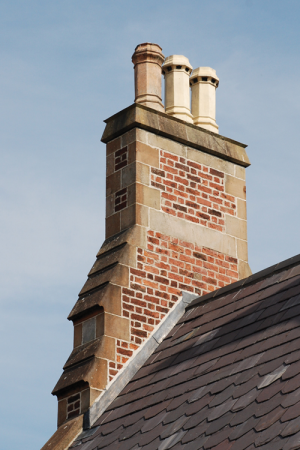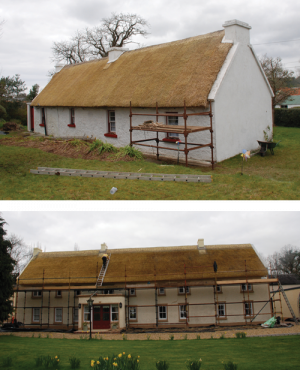Leaves and silt
Blocked gutters, particularly secret gutters, can lead to water penetrating external walls and wet rot in structural timbers which can require very costly repairs. Leaves and silt should be removed from gutters, flat roofs, downpipes, gully traps etc. roughly every three months and more frequently during the autumn fall of leaves.
Plant growth
Most historic buildings are constructed using lime mortar which has many features that make it a superior material to modern cement based mortar. After a century or more, however, it can become susceptible to damage from the roots of vegetation. Vegetation should be removed at regular intervals before the roots penetrate the structure.
Moss
Moss can harbour damp and cause slate to delaminate and should be removed. The acid run-off from moss and lichens will gradually erode all metals. There is a particular danger to lead work, but copper, zinc and iron are all at risk where these growths exist.
Bird droppings
Bird droppings can cause timber decay and should not be allowed to accumulate.
Plant and animal species protected by law
Certain species of plants and animals are protected by law. The Wildlife (Northern Ireland) Order 1985 (the Order) and amendment The Wildlife (Amendment) (Northern Ireland) Order 1995 prohibits the intentional killing, taking or injuring of certain wild birds and wild animals or the intentional destruction, uprooting or picking of certain wild plants.
Bats and pine martens are protected animals.
If you are planning any work on any building used by bats or where you think there may be pine marten activity – including treatment for woodworm, roof and thatch repairs or alterations, however minor – you must contact Wildlife Team, Department of Agriculture, Environment and Rural Affairs, Klondyke Building, Belfast before any work starts.
DAERA’s Wildlife Team can also offer advice on timetabling work to avoid nesting and breeding seasons and how to evict or deter unwanted bats and other protected species without causing harm.
Insect or fungal attack
Regular checks should be made for signs of active attack in the building timbers, such as bore holes and sawdust. If this is suspected, seek advice from a professional consultant or specialist contractor.
Snow
Snow should be removed from valley and parapet gutters where there is a danger that it could build up above the level of the lead flashings and so allow water into the building.
Woodwork, metalwork and render
Depending on the degree of exposure, external woodwork, render and metalwork should be repainted every three to five years. Lime render should be lime washed. A variety of colours are available and the washes, when properly constituted, will give a durable finish that will allow the wall to breathe. When considering windows pay attention to the state of the glazing, the glazing putty and the timberwork to ensure timber windows are in good order. Inside, the spaces behind timber sheeting and shutters can be particularly vulnerable to rot attack so investigate any smells of rot or the mustiness of damp.
Ventilation

The chimney and flue system are an integral part of the structure, function and aesthetic composition of a traditional building and often contribute to the character of the streetscape in which the building sits. They are structural elements that require care and maintenance although, due to their often inaccessible location, this is frequently omitted.
Chimneys not only animate the roofscape but are invaluable for ventilating historic buildings
Historic buildings achieve a balance between the uptake of moisture from internal as well as external sources, such as cooking, washing and rain, and its subsequent release.
When released internally the water vapour must be allowed to escape through ventilation openings and chimneys; otherwise condensation will occur which can lead to fungal attack.
Redundant chimneys should not be sealed for the same reason, but should be cleaned and weatherproofed as water accumulating in a disused flue can be very damaging.
Lead roofs, valleys and gutters
Lead sheets should be inspected for holes or splits that can lead to water penetration. The internal sign of water penetration is often far removed from the defect, as water will often move horizontally through the structure before finding a vertical path. Small repairs may be made using lead patches or whole sheets may need to be replaced. Either way this is a job for a specialist contractor.
Lead Flashings
Slipped lead flashings should be refixed, and damaged ones replaced, as soon as possible.
Slates and tiles
Slipped slates can lead to water penetration. Loose and slipped slates or tiles should be re-fixed as soon as possible, and broken slates or tiles replaced with matching ones.
Thatch

Thatched roofs need regular, usually minor, repairs as a result of natural decay, wind or animal damage, and this should be carried out in a matching material by an experienced thatcher. Contact HED for the most up to date advice on repairing your thatched roof and remember that changing the original material, for example from flax to water reed. Requires Listed Building Consent.
Consideration should be given to nearby trees and/or vegetation height: the need to keep thatched roofs free from falling leaves and to allow free ventilation/ natural airflow across the roof.
Bituminous Sheet Flat Roofs
Flat roofs pose a number of problems different from those encountered in pitched roofs. As they are not as proficient at shedding water, any defect can have serious implications for the building. They also may not receive the attention they require as inspection is sometimes difficult.

